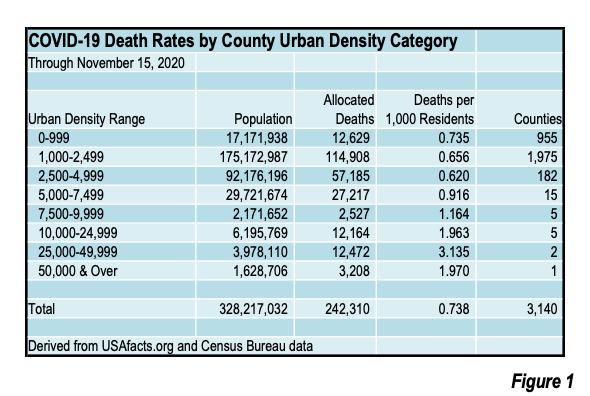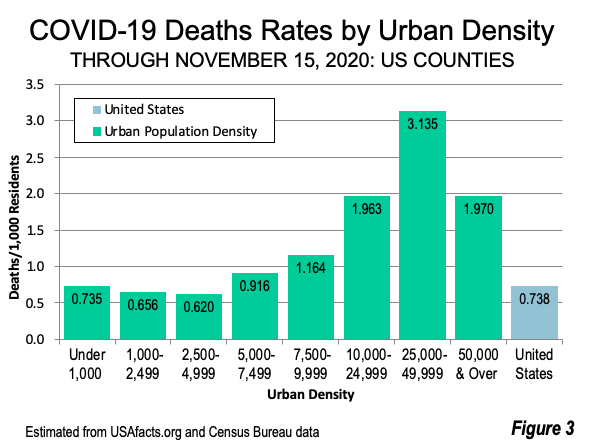The latest death rates from COVID-19 are displayed by county urban density in Figure 1. Death rates remain at or below the national average per 1,000 residents in county categories with urban densities of 5,000 per square mile or below (Figures 1 and 2). More than 85% of the nation’s residents live in these areas, which have rural or low to medium density suburban areas. All categories of counties with urban densities exceeding 5,000 per square mile have more than their population proportionate share of Covid-19 deaths.


Urban density is important. Covid infections and deaths are associated with higher urban densities. This is not because population density is a problem in itself. It is rather that in high urban densities it is more difficulty to avoid higher exposure densities, because the intensity and duration of risky contacts is likely to be greater. These areas are often characterized by worrying overcrowding from insufficiently ventilated enclosed spaces, such as elevators, transit, offices and public buildings (see: The Subways Seeded the Massive Coronavirus Epidemic in New York City by MIT economist Jeffery E. Harris). Social distancing alone is not enough. According to The New York Times: Small, crowded, enclosed spaces are petri dishes for the coronavirus. An additional problem in higher density residential areas is overcrowded apartments, often necessary because lower income households often cannot afford detached houses with yards in which kids can play. There is an important poverty connection.
Similar relationships are evident elsewhere, such as in the United Kingdom and Japan.

Wendell Cox is principal of Demographia, an international public policy firm located in the St. Louis metropolitan area. He is a founding senior fellow at the Urban Reform Institute, Houston and a member of the Advisory Board of the Center for Demographics and Policy at Chapman University in Orange, California. He has served as a visiting professor at the Conservatoire National des Arts et Metiers in Paris. His principal interests are economics, poverty alleviation, demographics, urban policy and transport. He is co-author of the annual Demographia International Housing Affordability Survey and author of Demographia World Urban Areas.
Mayor Tom Bradley appointed him to three terms on the Los Angeles County Transportation Commission (1977-1985) and Speaker of the House Newt Gingrich appointed him to the Amtrak Reform Council, to complete the unexpired term of New Jersey Governor Christine Todd Whitman (1999-2002). He is author of War on the Dream: How Anti-Sprawl Policy Threatens the Quality of Life and Toward More Prosperous Cities: A Framing Essay on Urban Areas, Transport, Planning and the Dimensions of Sustainability.












